Abstract
Chronic thiamine deprivation in the rat leads to selective neuropathological damage to pontine structures. Onset of neurological symptoms of thiamine deprivation (ataxia, loss of righting reflex) was accompanied by selective decreases (of the order of 30%) in the activity of α-ketoglutarate dehydrogenase (αKGDH) in lateral vestibular nucleus and hypothalamus. Enzyme activities were decreased to a lesser extent in medulla oblongata, striatum and hippocampus and were unchanged in other brain structures. No changes in αKGDH occurred prior to the onset of neurological signs of thiamine deprivation. Administration of the central thiamine antagonist, pyrithiamine, results within 3 weeks in loss of righting reflex and convulsions and in more widespread neuropathological changes than those observed following thiamine deprivation. αKGDH activities were found to be substantially diminished in all brain regions studied following pyrithiamine treatment with most severe changes occurring in brain regions found to be vulnerable to pyrithiamine (lateral vestibular nucleus, hypothalamus, midbrain, medullapons). In some cases, αKGDH changes preceded the appearance of neurological symptoms of pyrithiamine treatment. Such decreases in αKGDH may explain previous findings of region-selective changes in energy metabolism and of decreased synthesis of glucose-derived neurotransmitters (acetylcholine, GABA, glutamate) in pyrithiamine-treated rat brain. Thiamine administration to symptomatic pyrithiamine treated rats resulted in reversal of neurological signs of encephalopathy and in normalisation of defective αKGDH activity in all brain regions. These findings suggest that the reversible neurological symptoms associated with Wernicke's Encephalopathy in man likely result from region-selective impairment of αKGDH.
Similar content being viewed by others
References
Peters, R. A. 1936. The biochemical lesion in vitamin B1 deficiency. Application of modern biochemical analysis in its diagnosis. Lancet 1:1161–1164.
Gaitonde, M. K., Fayein, N. A., andJohnson, A. L. 1975. Decreased metabolism in vivo of glucose into amino acids of the brain of thiamine-deficient rats after treatment with pyrithiamine. J. Neurochem. 24:1215–1223.
Butterworth, R. F. 1982. Neurotransmitter function in thiamine-deficiency encephalopathy. Neurochem. Int. 4:449–464.
Vorhees, C. V., Schmidt, D. E., andBarrett, R. J. 1978. Effects of pyrithiamin and oxythiamin on acetylcholine levels and utilization in rat brain. Brain Res. Bull. 3:493–496.
Butterworth, R. F., Hamel, E., Landreville, F., andBarbeau, A. 1979. Amino acid changes in thiamine-deficiency encephalopathy: some implications for the pathogenesis of Friedreich's Ataxia. Can. J. Neurol. Sci. 6:217–222.
Jolicoeur, F. B., Rondeau, D. B., Hamel, E., Butterworth, R. F., andBarbeau, A. 1979. Measurement of ataxia and related neurological signs in the laboratory rat. Can. J. Neurol. Sci. 6:209–216.
Glowinski, J., andIversen, L. L. 1966. Regional studies of catecholamines in the rat brain. J. Neurochem. 13:655–669.
Paxions, G., andWatson, C. 1982. The rat brain in stereotaxic coordinates Academic Press, New York.
Gibson, G. E., Ksiezak-Reding, H., Sheu, K. F. R., Mykytyn, V., andBlass, J. P. 1984. Correlation of enzymatic, metabolic and behavioral defects in thiamin deficiency and its reversal. Neurochem. Res. 9:803–814.
Lowry, O. H., Rosebrough, N. J., Farr, A. L., andRandall, R. J. 1951. Protein measurement with the Folin phenol reagent. J. Biol. Chem. 193:265–275.
Pincus, J. H., andWells, K. 1972. Regional distribution of thiamine-dependent enzymes in normal and thiamine-deficient brain. Exp. Neurol. 37:495–501.
Collins, G. H. 1967. Glial cell changes in the brain stem of thiamine-deficient rats. Am. J. Pathol. 50:791–803.
Robertson, D. M., Wasan, S. M., andSkinner, D. B. 1968. Ultrastructural features of early brain stem lesions of thiamine-deficient rats. Am. J. Pathol. 52:1081–1087.
Tellez, I., andTerry, R. D. 1968. Fine structure of the early changes in the vestibular nuclei of the thiamine-deficient rat. Am. J. Pathol. 52:777–794.
Pincus, J. H., andGrove, I. 1970. Distribution of thiamine phosphate esters in normal and thiamine-deficient brain. Exp. Neurol. 28:477–483.
Gubler, C. J. 1961. Studies on the physiological functions of thiamine. J. Biol. Chem. 236:3112–3120.
Butterworth, R. F., Giguère, J. F., andBesnard, A. M. 1985. Activities of thiamine-dependent enzymes in two experimental models of thiamine-deficiency encephalopathy: 1. The pyruvate dehydrogenase complex. Neurochem. Res. 10:1417–1428.
McCandless, D. W., andSchenker, S. 1968. Encephalopathy of thiamine deficiency: studies of intracerebral mechanisms. J. clin. Invest. 47:2268–2280.
Inoue, A., Shim, S., andIwata, H. 1970. The activation of thiamine diphosphatase by ATP in rat brain. J. Neurochem. 17:1373–1382.
Troncoso, J. C., Johnston, M. V., Hess, K. M., Griffin, J. W., andPrice, D. L. 1981. Model of Wernicke's encephalopathy. Arch. Neurol. 38:350–354.
Aikawa, H., Watanabe, I. S., Furuse, T., Iwasaki, Y., Satoyoshi, E., Sumi, T., andMoroji, T. 1984. Low energy levels in thiamine-deficient encephalopathy. J. Neuropathol. Exp. Neurol. 43:276–287.
Nose, Y., Iwashima, A., andNishino, H. 1974. Thiamine uptake by rat brain slices. Pages 157–168,in Gubler, C. J., Fujiwara, M., andDreyfus, P. M. (eds.), Thiamine, John Wiley, New York.
Cooper, J. R. 1968. The role of thiamine in nervous tissue: the mechanism of action of pyrithiamine. Biochim. Biophys. Acta 156:368–373.
Cooper, J. R., andPincus, J. H. 1979. The role of thiamine in nervous tissue. Neurochem. Res. 4:223–239.
Murdock, D. S., andGubler, C. J. 1973. Effects of thiamine deficiency and treatment with the antagonists, oxythiamine and pyrithiamine, on the levels and distribution of thiamine derivatives in rat brain. J. Nutr. Sci. Vitaminol. 19:237–249.
Bennett, C. D., Jones, J. H., andNelson, J. 1966. The effects of thiamine deficiency on the metabolism of the brain. J. Neurochem. 13:449–459.
Author information
Authors and Affiliations
Rights and permissions
About this article
Cite this article
Butterworth, R.F., Giguère, JF. & Besnard, AM. Activities of thiamine-dependent enzymes in two experimental models of thiamine-deficiency encephalopathy 2. α-ketoglutarate dehydrogenase. Neurochem Res 11, 567–577 (1986). https://doi.org/10.1007/BF00965326
Accepted:
Issue Date:
DOI: https://doi.org/10.1007/BF00965326



